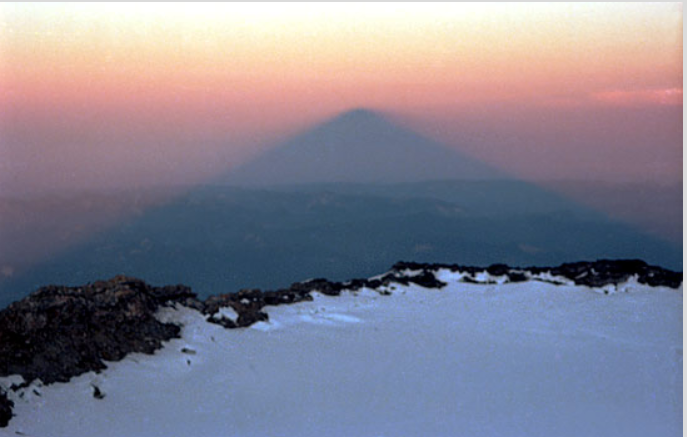Mountain Shadows
Mountain Shadows: Exploring the Fascinating Phenomenon
When standing at the summit of a mountain, one may notice a captivating sight - the triangular shadow cast onto the sky. This intriguing optical phenomenon, known as "Mountain Shadows," has fascinated observers for centuries. In this article, we will delve deeper into the mechanics behind these triangular shadows and uncover the factors that contribute to their formation.
From the vantage point of a mountain summit, virtually all mountain shadows appear triangular, regardless of the actual shape of the mountain itself. This visual effect is a result of perspective. As an observer stands at the top edge of a lengthy tunnel of shadowed air, they are essentially looking along its length. Although the cross-section of this tunnel mirrors the shape of the mountain, its "end" is so distant that it appears insignificant to the observer's eyes.
One important aspect that influences the appearance of mountain shadows is the finite size of the sun. The umbral (fully shaded) parts of the shadow converge and gradually taper away due to this factor. Consequently, there are limits to the length of umbral shadows. For instance, the umbral shadow of the Earth stretches over a staggering million miles. In comparison, the umbral length of a high mountain's shadow typically ranges from two to three hundred miles.
The phenomenon of triangular shadows is predominantly observed from objects of significant size, such as mountains. This is because smaller objects do not possess shadows long enough to exhibit a triangular shape. Therefore, it is the combination of the mountain's shape and the observer's perspective that creates this distinct triangular appearance.
Now, let us consider a specific example to illustrate this phenomenon further. Mt. Rainier in Washington State provides a remarkable instance of a triangular mountain shadow. A photograph taken by Dale Ireland from the summit at sunset in August '78 showcases this captivating sight. Interestingly, spending a night at the summit of Mt. Rainier is uncommon for climbers due to the unpredictable weather conditions. Even in seemingly clear weather, a cloud cap can form, and the biting cold can be numbing, causing even toothpaste to freeze.
To truly grasp the beauty and complexity of mountain shadows, it would be fascinating to compare the photograph taken at sunset with one captured the following morning. This comparison could potentially reveal variations in the shape and intensity of the shadow, providing a deeper understanding of the atmospheric conditions that contribute to this optical phenomenon.
It is worth noting that the formation of mountain shadows is not limited to a specific geographic location. Mountains across the globe have been observed to cast these triangular shadows, captivating the imaginations of those fortunate enough to witness this spectacle. From the majestic peaks of the Himalayas to the rugged ranges of the Andes, each mountain contributes its unique shape and character to the dance of light and shadow in the atmosphere.
In conclusion, mountain shadows are a captivating atmospheric optics phenomenon that has intrigued observers for generations. The triangular shape of these shadows is a result of perspective and the finite size of the sun. While smaller objects do not exhibit this phenomenon due to their shorter shadows, mountains provide an ideal canvas for this captivating display. Whether it is the imposing Mt. Rainier or any other majestic peak, the convergence of shape, perspective, and atmospheric conditions creates a mesmerizing spectacle that continues to inspire awe and wonder in all who witness it.

Mt. Rainier in Washington State casts an apparently triangular shadow onto the sky. Dale Ireland (site) took the image from the 14,400 ft summit at a sunset in August '78. "I think I also have a similar shot taken the next morning which would be interesting to compare. It is not common for climbers to actually spend the night at the summit of this mountain due to the unpredictable weather. A cloud cap can form even in otherwise clear weather and the cold is numbing. Even the toothpaste froze."Photo Dale Ireland, shown with permission
Seen from their summits almost all mountain shadows look triangular regardless of the mountain's shape. This is a perspective effect. You are standing at the top edge of a long tunnel of shadowed air and looking along its length. The tunnel's cross section is the shape of the mountain but its "end" is so far away that it looks insignificant. The finite size of the sun also causes the umbral (fully shaded) parts of the shadow to converge and eventually taper away. The tapering sets limits to the umbral length of shadows. That of the Earth is over a million miles. That of a high mountain can be two to three hundred miles. Triangular shadows are not seen from objects much smaller than mountains because their shadows are not long enough.
Note: this article has been automatically converted from the old site and may not appear as intended. You can find the original article here.
Reference Atmospheric Optics
If you use any of the definitions, information, or data presented on Atmospheric Optics, please copy the link or reference below to properly credit us as the reference source. Thank you!
-
<a href="https://atoptics.co.uk/blog/mountain-shadows/">Mountain Shadows</a>
-
"Mountain Shadows". Atmospheric Optics. Accessed on July 27, 2024. https://atoptics.co.uk/blog/mountain-shadows/.
-
"Mountain Shadows". Atmospheric Optics, https://atoptics.co.uk/blog/mountain-shadows/. Accessed 27 July, 2024
-
Mountain Shadows. Atmospheric Optics. Retrieved from https://atoptics.co.uk/blog/mountain-shadows/.